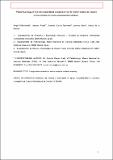Por favor, use este identificador para citar o enlazar a este item:
http://hdl.handle.net/10261/123675COMPARTIR / EXPORTAR:
 SHARE SHARE
 CORE
BASE CORE
BASE
|
|
| Visualizar otros formatos: MARC | Dublin Core | RDF | ORE | MODS | METS | DIDL | DATACITE | |

| Campo DC | Valor | Lengua/Idioma |
|---|---|---|
| dc.contributor.author | Peña-Melián, Ángel | - |
| dc.contributor.author | Rosas, Antonio | - |
| dc.contributor.author | García-Tabernero, Antonio | - |
| dc.contributor.author | Bastir, Markus | - |
| dc.contributor.author | De la Rasilla, Marco | - |
| dc.date.issued | 2011-06-28 | - |
| dc.identifier | doi: 10.1002/ar.21427 | - |
| dc.identifier | issn: 1932-8486 | - |
| dc.identifier | e-issn: 1932-8494 | - |
| dc.identifier.citation | Anatomical Record - Advan in Integr Anatomy and Evol Biology 294(8): 1370-1381 (2011) | - |
| dc.identifier.uri | http://hdl.handle.net/10261/123675 | - |
| dc.description.abstract | The endocranial surface description and comparative analyses of two new neandertal occipital fragments (labelled SD-1149 and SD-370a) from the El Sidrón site (Asturias, Spain) reveal new aspects of neandertal brain morphological asymmetries. The dural sinus drainage pattern, as observed on the sagittal-transverse system, as well as the cerebral occipito-petalias, point out a slightly differential configuration of the neandertal brain when compared to other Homo species, especially H. sapiens. The neandertal dural sinus drainage pattern is organized in a more asymmetric mode, in such a way that the superior sagittal sinus (SSS) drains either to the right or to the left transverse sinuses, but in no case in a confluent mode (i.e. simultaneous continuation of SSS with both right (RTS) and left (LTS) transverse sinuses). Besides, the superior sagittal sinus shows an accentuated deviation from of the mid-sagittal plane in its way to the RTS in 35% of neandertals. This condition, which increases the asymmetry of the system, is almost nonexistent neither in the analyzed Homo fossil species sample nor in that of anatomically modern humans. Regarding the cerebral occipito-petalias, neandertals manifest one of the lowest percentages of left petalia of the Homo sample (including modern H. sapiens). As left occipito-petalia is the predominant pattern in hominins, it seems as if neandertals would have developed a different pattern of brain hemispheres asymmetry. Finally, the relief and position of the the cerebral sulci and gyri impressions observed in the El Sidrón occipital specimens look similar to those observed in modern H. sapiens. © 2011 Wiley-Liss, Inc. | - |
| dc.description.sponsorship | Grant sponsor: Ministerio de Ciencia e Innovación of Spain; Grant number: CGL2009-09013; Grant sponsor: Convenio Consejería de Cultura-Universidad de Oviedo; Grant number:CN-09-084. | - |
| dc.publisher | John Wiley & Sons | - |
| dc.relation.isversionof | Postprint | - |
| dc.rights | openAccess | - |
| dc.title | Paleoneurology of Two New Neandertal Occipitals from El Sidrón (Asturias, Spain) in the Context of Homo Endocranial Evolution | - |
| dc.type | artículo | - |
| dc.identifier.doi | 10.1002/ar.21427 | - |
| dc.date.updated | 2015-10-21T11:01:50Z | - |
| dc.description.version | Peer Reviewed | - |
| dc.language.rfc3066 | eng | - |
| dc.rights.license | http://creativecommons.org/licenses/by-nc-sa/4.0/ | - |
| dc.relation.csic | Sí | - |
| dc.type.coar | http://purl.org/coar/resource_type/c_6501 | es_ES |
| item.grantfulltext | open | - |
| item.cerifentitytype | Publications | - |
| item.openairecristype | http://purl.org/coar/resource_type/c_18cf | - |
| item.fulltext | With Fulltext | - |
| item.openairetype | artículo | - |
| Aparece en las colecciones: | (MNCN) Artículos | |
Ficheros en este ítem:
| Fichero | Descripción | Tamaño | Formato | |
|---|---|---|---|---|
| AnatRecord 294(8) 1370-1381 (2011) POSTPRINT.pdf | 233,65 kB | Adobe PDF |  Visualizar/Abrir |
CORE Recommender
SCOPUSTM
Citations
17
checked on 12-abr-2024
WEB OF SCIENCETM
Citations
15
checked on 26-feb-2024
Page view(s)
335
checked on 15-abr-2024
Download(s)
270
checked on 15-abr-2024
Google ScholarTM
Check
Altmetric
Altmetric
Este item está licenciado bajo una Licencia Creative Commons

